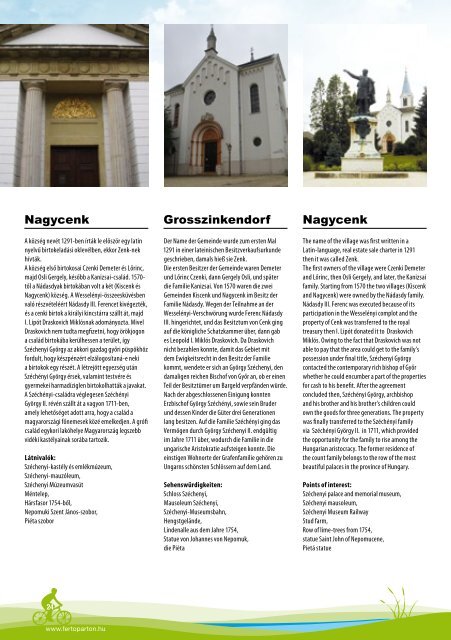Fertő parti
Fertő parti
Fertő parti
Sie wollen auch ein ePaper? Erhöhen Sie die Reichweite Ihrer Titel.
YUMPU macht aus Druck-PDFs automatisch weboptimierte ePaper, die Google liebt.
Nagycenk<br />
A község nevét 1291-ben írták le először egy latin<br />
nyelvű birtokeladási oklevélben, ekkor Zenk-nek<br />
hívták.<br />
A község első birtokosai Czenki Demeter és Lőrinc,<br />
majd Osli Gergely, később a Kanizsai-család. 1570től<br />
a Nádasdyak birtokában volt a két (Kiscenk és<br />
Nagycenk) község. A Wesselényi-összeesküvésben<br />
való részvételéért Nádasdy III. Ferencet kivégezték,<br />
és a cenki birtok a királyi kincstárra szállt át, majd<br />
I. Lipót Draskovich Miklósnak adományozta. Mivel<br />
Draskovich nem tudta megfizetni, hogy örökjogon<br />
a család birtokába kerülhessen a terület, így<br />
Széchenyi György az akkori gazdag győri püspökhöz<br />
fordult, hogy készpénzért elzálogosítaná-e neki<br />
a birtokok egy részét. A létrejött egyezség után<br />
Széchényi György érsek, valamint testvére és<br />
gyermekei harmadíziglen birtokolhatták a javakat.<br />
A Széchényi-családra véglegesen Széchényi<br />
György II. révén szállt át a vagyon 1711-ben,<br />
amely lehetőséget adott arra, hogy a család a<br />
magyarországi főnemesek közé emelkedjen. A grófi<br />
család egykori lakóhelye Magyarország legszebb<br />
vidéki kastélyainak sorába tartozik.<br />
Látnivalók:<br />
Széchenyi-kastély és emlékmúzeum,<br />
Széchenyi-mauzóleum,<br />
Széchenyi Múzeumvasút<br />
Méntelep,<br />
Hársfasor 1754-ből,<br />
Nepomuki Szent János-szobor,<br />
Piéta szobor<br />
24<br />
www.fertoparton.hu<br />
Grosszinkendorf<br />
Der Name der Gemeinde wurde zum ersten Mal<br />
1291 in einer lateinischen Besitzverkaufsurkunde<br />
geschrieben, damals hieß sie Zenk.<br />
Die ersten Besitzer der Gemeinde waren Demeter<br />
und Lőrinc Czenki, dann Gergely Osli, und später<br />
die Familie Kanizsai. Von 1570 waren die zwei<br />
Gemeinden Kiscenk und Nagycenk im Besitz der<br />
Familie Nádasdy. Wegen der Teilnahme an der<br />
Wesselényi-Verschwörung wurde Ferenc Nádasdy<br />
III. hingerichtet, und das Besitztum von Cenk ging<br />
auf die königliche Schatzkammer über, dann gab<br />
es Leopold I. Miklós Draskovich. Da Draskovich<br />
nicht bezahlen konnte, damit das Gebiet mit<br />
dem Ewigkeitsrecht in den Besitz der Familie<br />
kommt, wendete er sich an György Széchenyi, den<br />
damaligen reichen Bischof von Győr an, ob er einen<br />
Teil der Besitztümer um Bargeld verpfänden würde.<br />
Nach der abgeschlossenen Einigung konnten<br />
Erzbischof György Széchényi, sowie sein Bruder<br />
und dessen Kinder die Güter drei Generationen<br />
lang besitzen. Auf die Familie Széchényi ging das<br />
Vermögen durch György Széchenyi II. endgültig<br />
im Jahre 1711 über, wodurch die Familie in die<br />
ungarische Aristokratie aufsteigen konnte. Die<br />
einstigen Wohnorte der Grafenfamilie gehören zu<br />
Ungarns schönsten Schlössern auf dem Land.<br />
Sehenswürdigkeiten:<br />
Schloss Széchenyi,<br />
Mausoleum Széchenyi,<br />
Széchenyi-Museumsbahn,<br />
Hengstgelände,<br />
Lindenalle aus dem Jahre 1754,<br />
Statue von Johannes von Nepomuk,<br />
die Pièta<br />
Nagycenk<br />
The name of the village was first written in a<br />
Latin-language, real estate sale charter in 1291<br />
then it was called Zenk.<br />
The first owners of the village were Czenki Demeter<br />
and Lőrinc, then Osli Gergely, and later, the Kanizsai<br />
family. Starting from 1570 the two villages (Kiscenk<br />
and Nagycenk) were owned by the Nádasdy family.<br />
Nádasdy III. Ferenc was executed because of its<br />
<strong>parti</strong>cipation in the Wesselényi complot and the<br />
property of Cenk was transferred to the royal<br />
treasury then I. Lipót donated it to Draskovich<br />
Miklós. Owing to the fact that Draskovich was not<br />
able to pay that the area could get to the family’s<br />
possession under final title, Széchenyi György<br />
contacted the contemporary rich bishop of Győr<br />
whether he could encumber a part of the properties<br />
for cash to his benefit. After the agreement<br />
concluded then, Széchényi György, archbishop<br />
and his brother and his brother’s children could<br />
own the goods for three generations. The property<br />
was finally transferred to the Széchényi family<br />
via Széchényi György II. in 1711, which provided<br />
the opportunity for the family to rise among the<br />
Hungarian aristocracy. The former residence of<br />
the count family belongs to the row of the most<br />
beautiful palaces in the province of Hungary.<br />
Points of interest:<br />
Széchenyi palace and memorial museum,<br />
Széchenyi mausoleum,<br />
Széchenyi Museum Railway<br />
Stud farm,<br />
Row of lime-trees from 1754,<br />
statue Saint John of Nepomucene,<br />
Pietá statue


